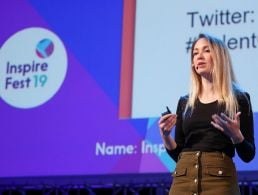Barbara McCarthy reflects on her career in tech and what leading teams has taught her about tackling diversity in STEM and engineering.
When I started working in the tech industry many moons ago, the topic of diversity wasn’t a ‘thing’. As a female engineer, I didn’t feel ‘diverse’ or like a ‘minority’. I didn’t feel any different from my colleagues.
Some of this might have been youthful innocence, ignorance or being just blissfully unaware. Having said that, there were more women working in engineering 30 to 40 years ago than there are now, according to NPR. I was incredibly lucky to work with some amazing teams that were completely gender-blind. It didn’t matter what you were as long as you got the job done and did it well.
As I progressed through my career, things started to change, sadly. The number of women working in the tech industry started to decrease. In recent years, I think the media has also played a part in highlighting minorities (and also some of the nightmare stories that needed to be told). When I think of diverse teams now as a tech leader, I don’t think of just gender diversity, I think of all types of diversity – gender, socioeconomic, sexual orientation, religious, ethnic, physical ability, experience level, age etc.
‘It may take an inordinate amount of effort to start to see change in the shape and make-up of the team but the further you go, the easier it gets’
Everyone knows that hiring a diverse team is not just an altruistic thing to do, it also makes good business sense. McKinsey research shows that gender-diverse companies are 15pc more likely to outperform their peers and ethnically diverse companies are 35pc more likely to do the same. So, how do you go about it and what has worked for us at HubSpot?
The five lessons I have learned are:
1. Diversity isn’t just a gender thing
For many people, gender is what springs to mind when the word diversity is mentioned. But it’s a ‘thought process’ thing.
In HubSpot, we don’t think about hiring targets as men versus women. We think about hiring people into the team who will add value to that team and provide a diversity of thought. This will allow us to build a better product. So, our diverse hires are, well, just that: diverse. They come in all shapes and sizes, genders, nationalities, religions, ages, physical abilities, backgrounds and sexual persuasions. And, the humbling thing to see is that the more diverse the team, the more accepting they are of other people and thought processes.
2. You have to put in the work
Hiring a truly diverse team is hard. In order to hire a diverse team, you need to just start. What I mean by that is, it won’t be easy and there is no easy path. It takes commitment, focus and a strategy. It may take an inordinate amount of effort to start to see change in the shape and make-up of the team but the further you go, the easier it gets.
‘We needed to build a larger funnel in order to see change further down in the recruitment process’
What we did in HubSpot was to start by focusing on building a more thoughtful pipeline, with more diverse candidates at the top of the recruitment funnel. Of course, this takes additional effort. We don’t want to compromise on quality of hires. We want to hire the best people for the job. So, essentially, we needed to build a larger funnel in order to see change further down in the recruitment process.
This has worked incredibly well but it does require more effort from our recruitment team. They are casting the net far wider and are tasked with implementing brand new outreach strategies.
3. Be the change you want to see
I have been leading and growing engineering teams for about 14 years. One thing that is very clear in hindsight is that people don’t aspire to be what they can’t see. We see ourselves in people who share our belief system, or who look like us, or have a similar background. If there are few female CEOs to look up to, for example, then girls have a harder time seeing themselves as CEOs one day.
This notion adds a chicken-and-the-egg complexity to recruitment. If you have diverse candidates but they can’t see anyone like them in your organisation, then it is harder for them to picture themselves working with you. But that’s why putting in the work, effort and energy to build a more diverse team is so important. The more diverse your team gets, the more inclusive it will be for prospective talent down the line.
4. Build a student pipeline
It’s easier to build a diverse student pipeline than it is at a senior level. New graduates are actively looking for great companies to work for, whereas senior engineers may have a lot of other factors that they need to consider when moving companies and therefore are slower to move.
Oftentimes, organisations will depend on the same handful of universities to recruit from. Maybe it’s the universities closest to your office, or the ones your employees went to and kindly refer friends from. Having these campus connections is invaluable, but it probably won’t help you diversify your pipeline long-term.
We took a long hard look at our campus recruitment strategy in HubSpot and realised we needed to expand our reach. Now, we are actively trying to build relationships with universities we’ve never hired from before. For example, we host an annual Connected event, student coding workshops and Women’s Web App Workshop in our offices where we teach students from diverse backgrounds how to code, interview tips, how to write a CV and more.
Whether you host workshops or do classroom visits, work with your recruitment team to brainstorm how you can add value for all universities, not just leading universities.
5. Lead with humility
You’re never going to get diversity ‘right’. There’s no easy answer or solution to building a team and workplace that is truly inclusive of all people and to all schools of thought. That’s why, as leaders, we need to get comfortable with humility. We are going to make mistakes sometimes. We might unintentionally alienate some employees by trying to make others feel included and heard. We might suggest an initiative without understanding all sides of the story.
What matters is that we are able to admit when we are wrong and learn from our mistakes, because the most important thing we can do in building diverse teams is to get started. We can’t afford to shy away from hard problems. For our employees, teams, organisation and the tech community, we have to make inclusion a priority.
Barbara McCarthy is director of engineering at HubSpot. If you’d like to learn more about building diverse teams, she will be hosting a huddle in HubSpot’s Recharge Lounge at Inspirefest 2018 to share her insights. Check the agenda to save your spot!
Inspirefest is Silicon Republic’s international event connecting sci-tech professionals passionate about the future of STEM. Get your tickets now to join us in Dublin on 21 and 22 June 2018.




